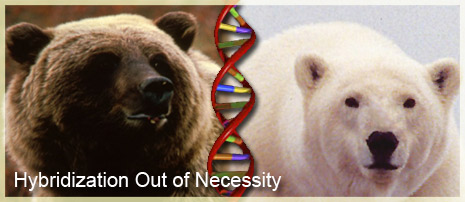
If you are a fan of National Geographic then I am sure you have witnessed their latest awe inspiring venture into the “Kingdom of the Blue Whale”, and if not, what are you waiting for! I don’t want to get sucked into rehashing the program itself, but the point I was most interested in was the discussion of blue and fin whale hybrids. An event that is very rare in terms of documentation, with observations topping out at a mere 11. Ironically, the “Kingdom of the Blue Whale” was followed up by a documentary highlighting the 2006 discovery (killing) of a Polar bear/Grizzly hybrid. Yes, perhaps old news now, but it was the perfect catalyst to jot down a few notes on hybridization and the potential problems, or maybe evolutionary strategies, it poses to biodiversity.
Extinction through hybridization generally manifests itself in three ways, but a fourth may be on the horizon:
1) Introduction of exotic and invasive species providing a means for gene pool mixing (introgression). Examples include breeding between feral domesticated cats and wildcats, Felis silvestris, in Scotland as well as in African wildcats, Felis libyca. More well known examples have popped up with reintroduction efforts of the red wolf, in which conservationists have uncovered gray wolf and coyote DNA in the genes of this endangered mammal.
2) Changes to habitat that bring once isolated species together. Local and regional habitat modifications including clearcutting, agriculture and even reforestation have resulted in tree frog hybridizations and the interbreeding between blue-winged warblers and golden-winged warblers.
3) Direct human interference. Conservation efforts involving attempts to rescue dwindling populations by crossbreeding related species or subspecies, introduction of closely related species to enhance wild animal stocks (Florida panther, wood bison, wisent), or through wildlife farming (i.e. salmon) in which such individuals when released into the wild interact with natural populations.
4) Indirect human interference. Species with depleted numbers, which may actually be directly human-induced, are unable to find mates of their own species locally, and/or are forced to travel further and into new regions in search of food, mates, and suitable habitat. By migrating out of traditional habitat or by simply a lack of numbers, animals come into contact with once isolated species, a process that perhaps created evolutionarily distinct species in the first place. As species co-mingle the chances of interbreeding increases as does introgression.
In the case of blue/fin whales and polar/grizzly bears, all of these species are listed in the U.S. as threatened and endangered, which leads one to believe that there just might be something to indirect human induced hybridization. Out of a shear will to survive, nature finds a way and with dwindling wildlife populations, shrinking habitats, climate change, clearcutting, urbanization, human population growth, noise pollution, and all the other usual suspects I believe we should not really be surprised by this response.
Stay tuned next week for The Hybridization Evolution Strategy.


[…] a related note, check out my previous piece Hybridization Out of Necessity on […]